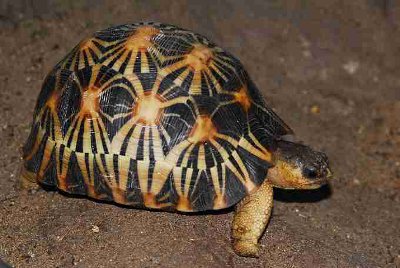Radiated Tortoise
Category: Turtle

Facts about Radiated Tortoises. "Scientific name for Radiated Tortoise is Astrochelys radiata". This is an Astrochelys type of tortoise that comes from the Testudinidae family. The Radiated Tortoise hail from southern Madagascar, and they can be largely found in the islands of Mauritius and Réunion. Usually, the Radiated Tortoise prefer to live in arid areas of brush, thorn woodlands, and in the forests of southern Madagascar. The Radiated Tortoise is measured to be one among the most stunning tortoises of the world.
Features of Radiated Tortoise
An adult Radiated Tortoise is capable of growing to a maximum carapace length of 16 inches (40 cm) and has a maximum body weight of 35 pounds (15.8 kg). The Radiated Tortoise has the essential body shape that is made up of elevated-domed carapace, a rounded head, and elephantine feet. The color of its head, legs and feet is yellow apart from an erratic sized black-colored patch on top of its head.
The Radiated Tortoise has its carapace brilliantly marked with yellow color stripes, shining from the middle of each dark plate of its shell, and hence the reptile attains its name. This star outline of this Radiated Tortoise variety is more delicately detailed and complicated than the usual pattern of other star-outlined varieties of tortoises. The Radiated Tortoises are also bigger than other varieties and they have a minor sexual dimorphism. Usually, the male Radiated Tortoise has a tail that is longer than that of the female ones. The notches beneath the tail of these male Radiated Tortoises are more noticeable than the females.
The Radiated Tortoise is an herbivorous reptile, and they are recognized to graze regularly in the similar area, thus keeping the plants in that region closely trimmed. The Radiated Tortoise usually prefer new development rather than mature development due to the low-fiber, high-protein content. However, these tortoises are endangered, mostly due to the obliteration of their home by humans and owing to poaching.
Diet of Radiated Tortoises
The Radiated Tortoise is an herbivorous reptile, and their regular diet comprises 90% of grazing. They also feed on succulent plants and fruits. However, their favorite food is the Opuntia cacti in the wild.
Reproduction of Radiated Tortoises
The male Radiated Tortoise will attain the sexual maturity when it attains a body length of 12 inches (30 cm), whereas the females will require some more inches (centimeters) in length to attain the sexual maturity. During mating, the male Radiated Tortoise starts a fairly loud procedure by bobbing its head and sniffing the back legs and cloaca of the female tortoise. In some situations, the male Radiated Tortoise may hoist the female tortoise by means of the front rim of its shell to prevent her from moving away.
Then, the male Radiated Tortoise proceeds to mount the female tortoise from the back at the same time as striking the anal area of his plastron against the carapace of the female tortoise. Hissing and murmuring during mating is frequent in males. This is an extremely hazardous process, as there is a risk that the shell of the female tortoise may crack and penetrate the anal and vaginal cavities. The female Radiated Tortoise lays eggs, ranging from 3 to 12 eggs in an earlier 8-foot (2.4 meters) excavated hole and then, it will leave the place.
The gestation period is fairly long in this tortoise variety, usually lasting between 5 and 8 months. Juvenile tortoises will bear the body length that ranges from 1.25 inches to 1.6 inches (3.2 to 4cm)after hatching. They have a white to an off-white shade body color, and they get the elevated-domed carapace quickly subsequent to hatching.
The average lifespan of the Radiated Tortoise in the wild ranges from 40 years to 50 years, whereas in the captive, they live up to 100 years.

 Back To Category Turtle
Back To Category Turtle